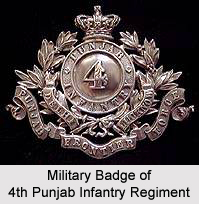 The 4th Punjab Infantry Regiment was an army infantry unit that was formed in 1849 under the British Indian Army. In 1903, the unit was renamed as the 57th Wilde`s Rifles (Frontier Force); and was later designated as the 4th Battalion (Wilde`s) 13th Frontier Force Rifles in the year 1922. The 4th Punjab Infantry Regiment was raised by Captain George Gladwin Denniss II (1st European Bengal Fusiliers) of the Honourable British East India Company on 18 April 1849 at Lahore. Initially it was a part of the Trans-frontier Brigade, which was later developed as the Punjab Irregular Force (PIF) in the year 1851.
The 4th Punjab Infantry Regiment was an army infantry unit that was formed in 1849 under the British Indian Army. In 1903, the unit was renamed as the 57th Wilde`s Rifles (Frontier Force); and was later designated as the 4th Battalion (Wilde`s) 13th Frontier Force Rifles in the year 1922. The 4th Punjab Infantry Regiment was raised by Captain George Gladwin Denniss II (1st European Bengal Fusiliers) of the Honourable British East India Company on 18 April 1849 at Lahore. Initially it was a part of the Trans-frontier Brigade, which was later developed as the Punjab Irregular Force (PIF) in the year 1851.
History of 4th Punjab Infantry Regiment
The 5 major Punjab Infantry regiments of the Trans-frontier Brigade were included as a part of the newly formed Punjab Irregular Force, (PIF) in 1851. Its members were renowned as the Piffers. Later in the year 1865, the Punjab Irregular Force, (PIF) was designated as the Punjab Frontier Force.
The 4th Punjab Infantry Regiment fought in the Second Afghan War and also participated in a military expedition to Waziristan in 1894. The troops were stationed at China during the Boxer Rebellion in 1900. The army unit was designated as the 57th Wilde`s Rifles (Frontier Force) during the reforms in the British Indian Army by Lord Kitchener in 1903. The battalion served on the Western Front in France and Belgium during the First World War. It took part in the Battle of La Bassee, the Battle of Messines, the Battle of Givenchy, the Battle of Neuve Chapelle, and the Second Battle of Ypres. The regiment was later sent to German East Africa in the year 1916. A second battalion of the 4th Punjab Infantry Regiment in 1918, but the unit was dissolved eventually. The unit also participated in the Third Afghan War in 1919.
The British Government of India restructured the British Indian Army in 1922 and the various single infantry regiments were merged to form larger multi battalion infantry units of four to six battalions. The 4th Punjab Infantry Regiment was joined with the 58th Vaughan`s Rifles, 55th Coke`s Rifles, 59th Royal Scinde Rifles and the 2 battalions of 56th Punjabi Rifles (Frontier Force) to create the 13th Frontier Force Rifles regiment. It became the 4th Battlaion of the new regiment.
The regiment participated in the British invasion of Iraq in 1941 during the Second World War. It later took part in the Syria Lebanon Campaign. The battalion also fought in the Battle of Gazala in North Africa in the year 1942.
Commanding Officers of 4th Punjab Infantry Regiment
The list of the Commanding Officers of the 4th Punjab Infantry Regiment is given below-
* Captain O. Marshall (1849- 1850)
* Captain G. G. Denniss (1850- 1851)
* Captain G. W. G. Bristow (1851- 1852)
* Captain T. P. Walsh (1852- 1853)
* Lieutenant A. T. Wilde (1853- 1862)
* Major J. Cockburne Hood (1862- 1873)
* Major F. T. Bainbridge (1873- 1876)
* Lieutenant Colonel H. T. Close (1876- 1882)
* Lieutenant Colonel A. J. D. Hawes (1883- 1891)
* Lieutenant Colonel A. McCrae Bruce (1891- 1894)
* Lieutenant Colonel O. C. Radford (1894- 1903)
* Lieutenant Colonel L. E. Cooper (1903- 1905)
* Lieutenant Colonel G. B. Hodson (1905- 1912)
* Lieutenant Colonel T. E. Scott (1912- 1914)
* Lieutenant Colonel F. W. B. Gray (1914- 1916)
* Lieutenant Colonel T. J. Willans (1916- 1921)
* Lieutenant Colonel G. L. Pepys (1921- 1926)
* Lieutenant Colonel E. D. Galbraith (1926- 1930)
* Lieutenant Colonel C. M. S. Manners (1930)
Designations of 4th Punjab Infantry Regiment
The military unit had various titles and designations during it service under the British Indian Army. These are mentioned as follows -
* 4th Regiment of Punjab Infantry, Transfrontier Brigade (Denniss Ka Pultan) in 1849
* 4th Regiment of Punjab Irregular Force in 1851
* 4th Regiment of Infantry, Punjab Frontier Force in 1865
* 4th Punjab Infantry in 1901
* 57th Wilde`s Rifles (Frontier Force) in 1903
* 4th Battalion (Wilde`s), 13th Frontier Force Rifles in 1922
* 4th Battalion (Wilde`s), The Frontier Force Rifles in 1945



















